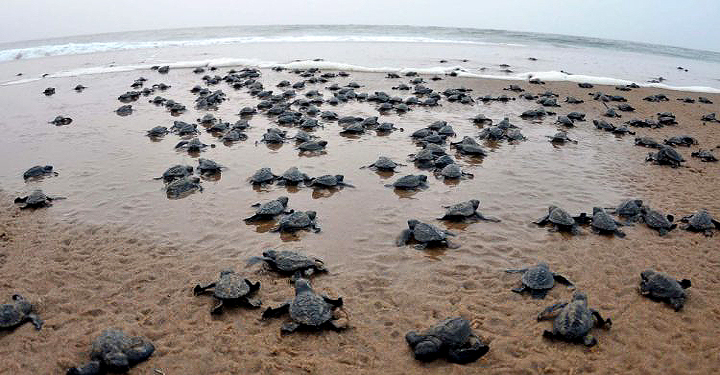Berhampur/Kendrapara: More than 10 lakh Olive Ridley turtles have crawled ashore this year to the two major mass nesting sites in Odisha to lay eggs in one of the largest congregations of the vulnerable species, officials said.
The number was much less last year since no mass nesting had taken place at Rushikulya in 2021. Around 7.30 lakh turtles had turned up for mass nesting in both Gahirmatha and Rushikulya in 2020. The migratory turtles, deriving their name from the olive-green shell, travel from the South Pacific Ocean and turn up in millions every year at the Odisha coast, the largest mass-nesting site for the species.
This year, incidentally, the congregation at the Rushikulya estuary (river mouth) in Ganjam district was more than Gahirmatha, one of the world’s most important nesting beaches for the sea turtle species.
According to a forest official, a record number of 5.5 lakh turtles congregated at the Rushikulya estuary during the eight-day mass nesting that ended on Sunday.
“The nesting, which began on the five-km-long island near the Rushikulya river mouth on March 27, broke all the records at the rookery,” Berhampur Divisional Forest Officer (DFO) Amlan Nayak said.
The previous highest at Rushikulya was 4.82 lakh in 2018. There was sporadic nesting last year, but no mass nesting, Nayak said.
“We can’t say why more turtles preferred the Rushikulya rookery. It’s a natural phenomenon,” Nayak said.
Around five lakh marine turtles arrived at the Gahirmatha Marine Sanctuary in Kendrapara district this year, for over four days since March 25, Rajnagar Mangrove (Wildlife) Divisional Forest Officer J D Pati said.
In Gahirmatha last year, around 3.5 lakh Olive Ridleys, the most abundant and one of the smallest sea turtle species in the world, had turned up en masse from March 9-23.
Meanwhile, at least a dozen female adult turtles, out of around 500 tagged by the Zoological Survey of India in the Rushikulya rookery last year to study their nesting behaviour, have returned to the same beach to lay eggs, scientists said.
The Olive Ridley falls under the vulnerable category of the International Union for Conservation of Nature’s red list of threatened species. Illegal egg poaching, turtle harvesting, and nest destruction by humans are some of the threats they face besides climate change and coastal erosion that is shrinking their breeding zones.
According to the World Wide Fund for Nature, they breed in very few places, and therefore, any disturbance in even one nesting beach could have huge repercussions on the entire population.
During ‘arribada’ or the arrival, the female turtles, to lay eggs, generally reach the beaches in the dead of the night. Usually, each female turtle lays around 120-150 eggs and returns to the sea.They usually mate between November and January and the breeding period lasts till May. The hatchlings emerge from these eggs after 45-60 days and grow up without their mothers. Various reports suggest that out of every 1,000 hatchlings which enter the sea, only one manages to reach adulthood.
PTI



